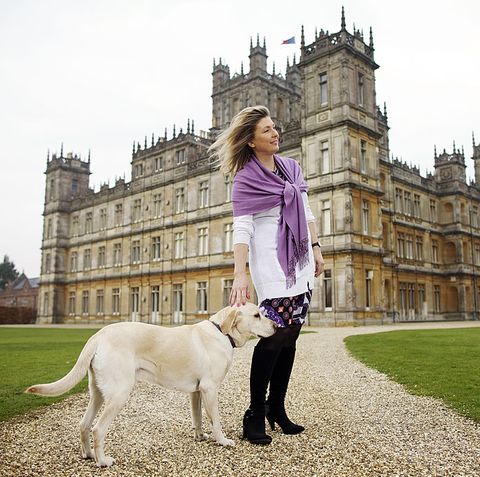
The Real Downton Abbey
Its the most watched costume drama in the world. Contributor MATTHEW FLACKS chats with Countess Fiona Carnarvon about how she and her predecessors save a modern castle.

Highclere Castle
I’ve dialed in and now eavesdrop on the staff at Highclere Castle. “Just wondering which office she’s in. I mean she left ten minutes ago, and it takes a while to walk from one place to another around here so….” Wow. This really is a castle. And as I’m listening to the musical intermission whilst the Lady of the manor is otherwise lost in a maze of rooms and corridors, I think that maybe this is a bad idea. As if enough hadn’t been pontificated and gushed over Downton Abbey, and along comes yet another tedious article about posh and poor, them and us, with the incessant, excitable droning on over a breech or a bodice. Not to mention the Ladies and Lords and commoners and peasants. Oh, the ennui. Luckily, my fears are unfounded. The current, true chatelaine of Highclere Castle, the setting for the indomitable worldwide televisual phenomenon Downton Abbey, pluckily interrupts my classical interlude, and assures me that fiction does not always reflect fact. The reality of running an authentic castle in the 21st century, situated in the middle of the sprawling English countryside, often amounts to a fish-and-chip supper with the painters and decorators, nattering over the pipes and drains rather than scoffing on Salmon en Croute with fellow aristocrats. How very provincial. This could be more interesting than I thought. History focuses on men with insufficient consideration given to their spouses. The Ladies of Highclere are changing that. It is clear that Highclere Castle acts as a character in its own right, a personality if you like in that it outlives all its inhabitants and has an imposing and elegant quality that outstrips any glamour or scandal that any protagonist may deign on it. The Countess has full respect for this heritage it seems, and suggests that her home is ‘not mine to have, but mine to earn – don’t assume it, earn it.’ In any family estate, here’s the deal: Earls and Countesses and Dukes and Duchesses merely come and go, keeping the seat warm for the next-in-line (expensive as the heating bills may be). Highclere’s vivid history and remarkable setting lends itself to playing the show-stealing central character. One can just hear the actors’ uncontrollable sobs from the Winnebagos. No wonder Julian Fellowes, a personal friend of the Carnarvons, earmarked it from Downton’s inception as the preferred location. Such country retreats transcend time; from the four hundred-year-old trees to the magnificent paintings of Van Dyck, Canaletto, Reynolds et al which adorn the walls of the grand rooms. Yet Countess Carnarvon concedes that the success of Downton has put more pressure on she and her husband as guardians of this bastion of longevity.
Fiona, the 8th Countess of Carnarvon, appears to have pretty big Jimmy Choos to fill. One of her forebears, Lady Almina (the inspiration for Lady Cora in Downton), about whom she has written a book, was an exuberant character borne out of the Victorian era, with a penchant for expensive taste. The illegitimate but adored daughter of a rich banker, Sir Alfred de Rothschild, Almina married well. Her husband was the 5th Earl of Carnarvon, the most eligible of bachelors whose family seat resided at Highclere, and was later to gain international notoriety for discovering the tomb of Tutankhamen in 1922. The couple married in a lavish ceremony and were set to become the ‘it’ couple of their time when celebrity was a mere twinkle in history’s eye.
Lady Almina Carnarvon and her husband ‘strode the world stage,’ had intimate connections to royalty and were the darlings of high society, leading a fantastical life until war broke out in 1914. The Countess, with money and ambition behind her, turned the castle into a hospital for soldiers returning from the horrors of the frontline, with cutting-edge medicine and procedures that had been relocated from London. Highclere has been in the Carnarvon family since 1679, and the most recent incarnation of the castle was designed in 1842 by Sir Charles Barry (who also designed the Houses of Parliament). From being a decadent and entertaining country pile, with a staff of over 60, the war had an extraordinary impact. Lady Almina insisted on bringing the stricken men to recover in an idyllic setting amongst the 1,000 acres of beautiful parkland, and even set her guest rooms up as operating theaters. She even kitted her nurses out in high-fashion finery to inject the injured infantry with a gentle morale boost. One hundred years on, the incumbent Lady Carnarvon is now doing her bit. This summer, the castle with host ‘Heroes at Highclere’, an event to mark the centenary of the outbreak of war, to bring something positive to many men affected by conflict, and to continue the castle’s tradition as a place of healing, peace, and a ‘humanitarian icon.’
At the turn of the 20th century, Great Britain was in flux transforming itself into an avant-garde, progressive nation following years of social austerity, and Fiona reflects on this era with a certain air of romance and nostalgia. She explains that her book Lady Almina and The Real Downton Abbey was to lend a genuine spotlight on the setting for the most famous export of British television for a generation, as she felt fiction and reality were ‘muddled enough’. It reads very much like a silly parody of the series itself (if parody were possible), but I was soon slightly disappointed to acknowledge that it is indeed a historical assessment rather than entertaining satire. As Downton Abbey ‘is not history’, she felt compelled to pen a biographical book about one of her colorful predecessors.
The present Countess is jolly, succinct and pragmatic, all too aware and appreciative of the riches that the Downton brand has brought to her estate. She accepts that the series has given her a marketing platform for her two books (the second publication concerns Lady Catherine, successor to Lady Almina and her husband’s grandmother) and indulged her passion for writing. She tells me that she reveled in picking through the archives to unearth the truth about these ladies’ lives, as there is much propensity on the male roles – the Dukes, the Earls – and insufficient consideration given to their spouses. However, she emphasizes that she has no issue with the titles themselves or the paternal prevalence as they are there to keep the estates intact and ensure that they are not subdivided in awkward inheritance wrangling. Pragmatic indeed.
Running such a huge business is not merely a corporate responsibility but a historical imperative. There are farms to run, grounds to maintain, events to organise and staff to manage. Fiona revels in the ‘strong sense of time’ that Highclere represents, and says that her books are intended to provide readers with a durable sense of scenic situation, rather than being consumed by the ‘outrageous’ stories that Downton proffers. It is the portrayal of Highclere’s community that most endears her; its enduring legacy and constancy that has continued through the generations.
So does she insist on her ‘Lady’ prescription, I wonder? Well, when in London, she wouldn’t dream of going into the hairdresser and assuming her title (good job if you ask me. London can be ruthless), though she does admit that at Highclere, ‘it’s all a bit of a game’. A bit like Downton then. Romantics, rejoice.
Archives








